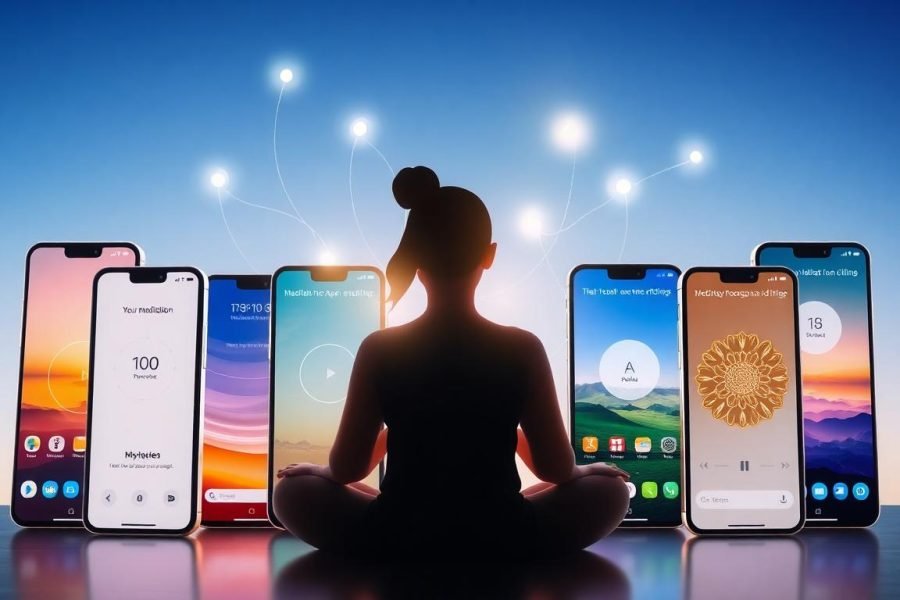Distractions in the workplace are one of the main challenges for anyone aiming for high-level performance, whether in an office or remote setting. Staying focused—especially amid constant notifications and overlapping demands—has become a crucial advantage.
Meditation has emerged as a powerful ally for professionals seeking to enhance concentration, reduce stress, and increase productivity. Through simple practices, it’s possible to incorporate mindful pauses into the workday and experience noticeable improvements in mental clarity and efficiency.
In this guide on how meditation can eliminate distractions and boost performance at work, you’ll learn practical strategies to strengthen attention and turn breaks into fuel for consistent daily results.
Understanding Distractions and Their Impact at Work
In today’s fast-paced office and home office environments, distractions take many forms and directly affect those striving for excellence. Recognizing and managing interruptions is an essential first step toward implementing strategies like meditation, the central focus of this guide on how meditation can eliminate distractions and boost performance.
The Main Sources of Distraction
Distractions are widespread across both physical and remote work settings. Understanding them helps build more practical and effective solutions:
- Digital notifications: Constant alerts from apps, emails, and social media fragment attention and disrupt deep work.
- Frequent interruptions: In offices, colleagues often make unscheduled requests. At home, family demands or external noise interfere with focus.
- Meeting overload: Excessive or unnecessary meetings drain mental energy and take time away from truly productive tasks.
- Poor work environment: Inadequate lighting, noise, lack of ergonomic furniture, and makeshift spaces (especially in home offices) make it harder to concentrate.
- Unstructured multitasking: The pressure to juggle multiple responsibilities leads to task-switching, decreasing overall efficiency.
These distractions aren’t just temporary annoyances—they accumulate throughout the day, making it harder to regain momentum and maintain quality in deliverables.
Effects of Distractions on Productivity and Well-Being
Constant distractions at work directly affect not only productivity but also professionals’ mental health:
Decline in focus and performance: Each interruption forces a mental reset. The brain needs time to regain its previous level of concentration, which leads to cumulative productivity losses.
Increased stress levels: Continuous stimuli and constant demands create a sense of permanent urgency. This triggers physiological stress responses, making it harder to relax even after hours.
Compromised results: Decision-making suffers when choices are made hastily. Details are overlooked, errors increase, and deadlines become harder to meet.
Procrastination: When distractions overwhelm, the mind looks for quick escapes—like social media or casual chats—delaying essential tasks.
Burnout and mental health issues: The mix of stress, pressure, and inability to disconnect can lead to burnout, anxiety, and emotional exhaustion.
Professionals in chronically distracted environments often report memory lapses, irritability, and dissatisfaction with their performance. In contrast, adopting practices that sharpen attention, like meditation, can drastically reduce these risks and foster a healthier, more productive routine.
How Meditation Affects the Brain and Enhances Focus at Work

The connection between meditation, focus, and performance in professional environments is becoming increasingly evident. Scientific studies show that meditation directly influences the brain circuits responsible for attention, emotional regulation, and stress response. Incorporating mindfulness into daily routines can transform how we manage pressure and decisions, unlocking team potential and improving well-being—whether in the office or at home.
Neuroscientific Insights and Stress Reduction
Recent studies have revealed that meditation produces significant changes in both brain structure and function. Three core benefits stand out:
Smaller and less reactive amygdala: The amygdala is the brain region responsible for processing intense emotions like fear and anger, acting as a threat-detection center. People who meditate regularly show a smaller and less active amygdala, which helps reduce emotional reactivity and improves decision-making under pressure.
Reduced cortisol levels: Cortisol, the primary stress hormone, drops significantly after just a few weeks of consistent practice. A recent Brazilian study found that participants who engaged in a 12-week meditation program experienced notable stress reduction, resulting in lower muscle tension, increased energy, and a more relaxed state after work.
Improved emotional resilience: Meditation strengthens the prefrontal cortex—the region associated with self-control, emotional regulation, and perspective-taking. This translates to more composed leadership, better teamwork, and greater adaptability in the face of workplace challenges.
Meditation also enhances neuroplasticity—the brain’s ability to reorganize itself and form new connections. As a result, people become more capable of processing stress and emotional memories with calm and acceptance, minimizing mental overload and supporting a healthier response to pressure in high-performance environments.
Mindfulness: Proven Benefits for Workplace Productivity
Mindfulness is no longer a niche practice—it’s a well-established tool adopted by leading organizations worldwide. The integration of mindfulness practices into corporate routines has yielded impressive results:
Increased performance: Companies like Google and Apple track performance improvements among employees who practice mindfulness. These teams often report higher productivity and more sustainable work rhythms.
Improved clarity and decision-making: Mindfulness enhances regions of the brain responsible for attention, creativity, and strategic thinking. This supports better analysis, clearer prioritization, and more effective problem-solving.
Reduced stress and anxiety at work: Short meditation sessions help balance mental energy, reducing pressure buildup and preventing burnout. Just 10 to 15 minutes of daily practice can relieve chronic anxiety, tension, and even improve sleep.
Boosted creativity: Regular mindfulness practice clears mental clutter and encourages cognitive flexibility, which leads to innovative thinking and faster ideation.
Strengthened collaboration and empathy: Workplaces that embrace mindfulness often report increased patience in meetings, mutual respect among colleagues, and fewer interpersonal conflicts.
Studies also show that:
- Regular mindfulness sessions significantly lower cortisol levels, fostering emotional well-being.
- Workplace mindfulness programs are linked to reduced absenteeism and improved engagement.
- Participants often experience a sharper sense of self-awareness, stronger emotional control, and greater empathy—all essential traits for high-performing teams.
The data makes it clear: meditation doesn’t just improve mental health—it fuels business results. When consistently practiced, it helps the brain operate with more clarity, resilience, and focus, directly impacting job performance and overall quality of life.
Meditation Practices to Eliminate Distractions and Boost Performance

Integrating meditation into your work routine is a powerful way to improve focus and manage constant interruptions, whether you work in a traditional office or remotely. Practicing consistently helps develop mindfulness, offering mental clarity and emotional resilience to handle daily challenges. If you’re looking to understand how meditation can eliminate distractions and enhance performance at work, it’s worth exploring accessible techniques and practical strategies to use during scheduled breaks.
Simple Meditation Techniques and Conscious Breaks
Adding short, mindful pauses to your workday can increase productivity and well-being without major lifestyle changes. Below are beginner-friendly practices you can start using immediately:
Conscious breathing exercises:
Take 2 to 5 minutes to close your eyes and focus solely on your breath. Inhale for four counts, hold for four, and exhale slowly. Techniques like the 4-7-8 breathing method calm the mind, reduce anxiety, and prepare your brain to reengage with tasks.
Short guided meditations:
Use meditation apps or audio guides to practice 5–10 minute sessions. Sit comfortably in your chair, wear headphones, and follow the voice instructions. These quick sessions can be used at the beginning of your day, after lunch, or anytime you feel your concentration slipping.
Walking meditation:
Stand up and walk slowly for two or three minutes, paying attention to your footsteps, the sensation of your feet touching the ground, and your breath. Even in small spaces, mindful walking can refresh your mind and counteract the fatigue of prolonged sitting.
Body scan practice:
During a break, close your eyes and mentally scan your body from head to toe. Notice areas of tension and consciously release them one by one. This practice reduces physical tension and restores mental balance before returning to work.
Tips for daily consistency:
Set automatic reminders using mindfulness apps or your smartphone.
Create a calming space with soft lighting, a comfortable chair, and minimal distractions.
Stick to regular time slots to establish the habit—short, frequent sessions are more effective than occasional long ones.
These techniques work well in both corporate offices and home environments. The key is to repeat small, intentional actions consistently, building a positive loop of focus, energy, and mental balance throughout the day.
Focus Strategies and Deep Work Combined with Meditation
To amplify how meditation can eliminate distractions and enhance performance at work, it’s essential to pair mindfulness practices with deep focus techniques and structured time management. The concept of “deep work,” popularized by productivity experts, encourages uninterrupted blocks of focused time to handle complex tasks with maximum efficiency and mental clarity.
Here are some practical strategies you can apply in your professional routine:
- Scheduled deep focus blocks:
Reserve 60 to 90-minute time slots to work on important tasks without distractions. Silence notifications, set your status to “do not disturb,” and begin with a two-minute breathing exercise to enter a calm and alert state of mind. - Revised Pomodoro Technique:
Work in 25-minute focused sprints followed by 5-minute breaks. After four cycles, take a longer break of 15 to 30 minutes. During these pauses, you can include short meditations or stretching exercises. This method balances effort with rest, reducing cognitive fatigue and sharpening mental clarity. - Focus-enhancing apps:
Tools like Forest, Focus To-Do, and RescueTime help you block digital distractions and monitor your focus habits. Some apps even include built-in guided meditations, making it easier to transition between work and recovery modes. - Distraction-free environments:
Design a clean, quiet workspace with only the essentials nearby. Adopt digital minimalism by closing tabs and muting unnecessary alerts. If you work in a shared space, signal to others when you need focused time—like updating your chat status to “in flow.” - Flow-state rituals:
Before diving into complex tasks, perform a brief mindfulness practice—such as a body scan or one-minute breathing pause. This signals your brain to shift into a high-performance state and helps prevent early distractions. - Best practice summary:
Group similar tasks together instead of jumping between different types of work.
Track your periods of focus and pause to fine-tune your weekly productivity rhythm.
Work in alignment with your natural energy cycles, scheduling the most demanding tasks during your mental peak hours.
When you combine meditation with deep work strategies and proactive time organization, you gain clarity, resilience, and momentum. This integration is key for achieving sustained performance in distraction-heavy environments.
Implementing Meditation in the Professional Routine

Adopting meditation in the workplace has evolved from a wellness trend into a proven strategy for enhancing organizational health. Companies that integrate mindfulness practices into their daily culture report tangible improvements in productivity, team dynamics, and overall satisfaction. To bring these benefits to life, it’s essential to design structured initiatives and track real results over time.
Organizational Culture and Corporate Examples
Company culture plays a critical role in the success of meditation programs. Major companies like Google, LinkedIn, Natura, SAP, Nike, and Accenture have introduced mindfulness initiatives and created designated areas called “Mindfulness Rooms”—quiet spaces for guided meditation, conscious breaks, and stress reduction.
Reported impacts in these organizations include:
- Stress and anxiety reduction: Some companies have observed up to a 58% drop in stress indicators among employees who consistently practice mindfulness.
- Increased productivity: Teams report up to a 25% rise in output, citing greater focus and fewer errors during work tasks.
- Better team dynamics and engagement: Ongoing meditation programs foster more respectful interactions, higher employee retention, and reduced internal conflicts.
- Less absenteeism and turnover: Some firms have seen up to a 50% decline in staff turnover and fewer sick days related to mental health concerns.
In addition to physical spaces, many organizations use meditation apps like Headspace and Calm, making mindfulness accessible to hybrid or remote teams. These platforms encourage daily practice regardless of location or schedule.
Best practices for building a mindfulness-based culture:
- Train leaders to champion mindfulness by modeling the behavior and encouraging participation.
- Integrate meditation into onboarding sessions, staff meetings, or periodic training to reach more team members.
- Communicate benefits in a clear and practical way to foster interest and reduce stigma.
When embedded into company values, meditation becomes more than just an optional perk—it’s a pillar of a sustainable, high-performance workplace.
Measuring Benefits and Sustaining Consistency
Meditation programs yield the best results when tracked with well-defined metrics and supported by ongoing engagement. Companies that seek to prove how meditation can eliminate distractions and boost performance at work often combine quantitative and qualitative indicators to assess impact.
Key performance indicators include:
- Productivity: Monitor task completion rates, deadlines met, and overall output.
- Employee satisfaction: Conduct climate surveys, internal NPS scores, and open feedback channels to gauge well-being and morale.
- Stress reduction: Use validated questionnaires to track stress, burnout, and mental health before and after implementing meditation.
- Absenteeism and turnover: Track employee absences and attrition, especially those tied to mental health reasons.
- Work quality: Observe changes in error rates, rework volume, creativity, and problem-solving abilities over time.
Business intelligence tools and health dashboards allow HR teams and leaders to analyze these trends and adjust strategies as needed. Many meditation apps also offer usage analytics, showing session frequency and engagement in real time.
Tips to promote consistency:
- Establish daily routines, like short meditations at the start of work or after key meetings.
- Launch collective mindfulness challenges to drive engagement through shared goals.
- Offer diverse formats—live, recorded, in-person, or app-based—to appeal to different employee profiles.
- Celebrate small wins by sharing success stories and testimonials from employees who experienced positive changes.
- Involve leadership directly—managers who practice and support mindfulness increase adoption and normalize the habit across teams.
A well-structured, continuously reinforced program turns meditation into a sustainable wellness tool rather than a short-term initiative. When people feel the benefits in both productivity and personal well-being, the practice naturally integrates into their daily rhythm.
Conclusion
Eliminating distractions is a game-changer for professionals striving for high performance and work-life balance. Throughout this guide, we’ve seen how meditation—when practiced consistently—produces measurable outcomes: sharper focus, lower stress levels, and increased productivity in both remote and in-office environments.
Simple techniques like conscious breathing, short guided sessions, and mindful pauses serve as practical solutions to daily interruptions. These practices also protect mental health and improve overall well-being.
Beyond individual benefits, meditation fosters healthier, more respectful, and collaborative professional relationships. Just a few minutes each day can reset your mindset and elevate your performance.
Encourage your team, colleagues, or leadership to explore these techniques together. Share your experience, track the results, and watch how the workplace transforms when presence and clarity become a shared value.
Thank you for reading this full guide on how meditation can eliminate distractions and enhance performance at work. Keep practicing and exploring new ways to grow professionally and personally—one breath at a time.panhar este conteúdo sobre como a meditação pode eliminar distrações e aumentar o desempenho no trabalho. Compartilhe suas experiências e continue explorando novas formas de crescer na vida profissional e pessoal.






Deixe um comentário